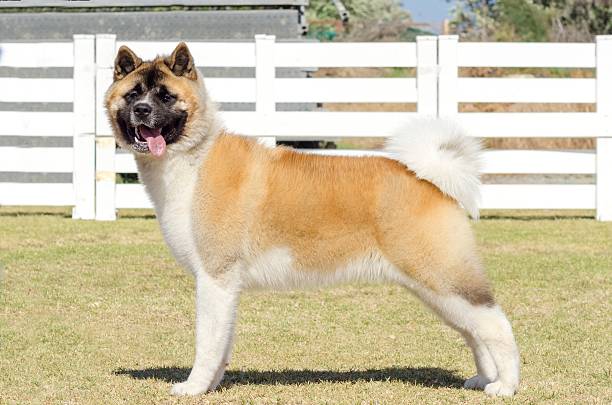American Akita

Breed History:
The American Akita, also known simply as the Akita, originated in Japan and was developed further in the United States after World War II. Originally bred for hunting large game like bears and boars in Japan’s rugged terrain, the breed was revered for its strength, loyalty, and noble appearance. When American servicemen brought Akitas home after the war, they selectively bred them for size and a more robust appearance, resulting in the distinct American variant.
While the Japanese Akita tends to have a more fox-like face and slender frame, the American Akita is larger, broader, and more bear-like in appearance. The breed has become a symbol of loyalty, famously exemplified by Hachiko, the Akita who waited years for his deceased owner—a story that further popularised the breed worldwide.
|
Gender |
Height |
Weight |
|
Male |
66–71 cm |
45–59 kg |
|
Female |
61–66 cm |
32–45 kg |
Size – Large
Life Expectancy: 10–13 years

Breed Appearance:
The American Akita is a large, powerful dog with a muscular build and commanding presence. It features a broad head with small, triangular eyes and erect ears that give it a keen, alert expression. The breed’s dense double coat can come in a variety of colours, including white, brindle, black, and pinto. The outer coat is coarse and straight, while the undercoat is soft and thick, providing insulation in cold climates.
Its thick, curled tail is a hallmark feature, carried proudly over its back. With strong limbs, a deep chest, and a solid frame, the American Akita exudes both dignity and physical strength. Despite its imposing appearance, it maintains an elegant and balanced stature.
Breed Type – Family/Guard:
The American Akita is a devoted guardian and loyal family companion. It is naturally protective and can be wary of strangers, making it an effective watchdog. With its calm, dignified demeanour, the Akita forms strong bonds with its family and often becomes particularly attached to one person.
However, this breed is not ideal for novice dog owners. It tends to be independent, stubborn, and sometimes aloof. Proper training and early socialisation are critical to ensure it gets along with other animals and unfamiliar people. While it can be affectionate and playful with family, it is known for being serious and territorial around outsiders.

Training:
The American Akita is intelligent and learns quickly, but its independent and dominant streak can make training a challenge. It responds best to confident, consistent leadership and early socialisation. A calm yet assertive trainer who uses positive reinforcement and firm boundaries will find success with this breed.
Harsh corrections or inconsistent discipline can lead to resistance or even aggression. The Akita requires a strong-willed owner who can establish trust and respect. While not typically eager to please like some breeds, it can excel in obedience, protection work, and even therapy roles with proper guidance.
Health & Care:
Generally, a robust and hardy breed, the American Akita is prone to certain genetic health issues. These include hip and elbow dysplasia, hypothyroidism, progressive retinal atrophy (PRA), and autoimmune disorders. It may also be at risk for bloat (gastric torsion), a serious condition requiring immediate medical attention.
Routine veterinary care, weight management, and a nutritious diet are crucial for maintaining its health. Regular exercise helps prevent obesity and keeps joints strong. Owners should monitor for signs of joint discomfort or skin allergies, which can occur due to the breed’s thick coat and genetic predisposition.

Living Conditions:
The American Akita is best suited for homes with ample space, such as a house with a secure yard. While it can adapt to indoor living, it thrives in environments where it can stretch and patrol its territory. Due to its territorial nature and strong guarding instincts, it should not be left alone with other dogs unless properly socialised from a young age.
Apartment living can be possible if the Akita receives enough daily exercise, but its size and energy levels make it more suitable for larger living spaces. It prefers cool climates due to its dense coat and can be prone to overheating in hot weather.
Exercise:
Although not hyperactive, the American Akita requires regular exercise to stay healthy and prevent boredom. Daily walks, play sessions, and mental stimulation through training or interactive games help keep it content and well-behaved.
The breed benefits from structured exercise, such as obedience or agility training, but care must be taken not to over-exercise growing puppies, as this can strain their developing joints. Off-leash time should only be in secure areas, as Akitas may exhibit strong prey drive and be inclined to roam.
Grooming:
The American Akita's double coat sheds heavily twice a year and moderately throughout the rest of the year. Daily brushing is necessary to manage the undercoat and reduce loose hair during shedding seasons. Outside of these periods, brushing once or twice a week is usually sufficient.
Bathing should be done occasionally or when the dog becomes dirty, using a gentle dog shampoo to avoid skin irritation. Routine care also includes nail trimming, ear cleaning, and regular dental hygiene. Due to its thick coat, it is important to check for parasites, especially during warmer months.

Advantages:
-
Loyal, protective, and forms strong bonds with its family
-
Excellent guard dog with strong territorial instincts
-
Intelligent and capable of learning complex tasks
-
Low barking tendency, generally quiet indoors
-
Beautiful, impressive appearance with dignified presence
-
Adaptable to cold climates thanks to its thick coat
Disadvantages:
-
Can be aggressive or dominant if not properly trained and socialised
-
Not ideal for first-time dog owners due to its strong-willed nature
-
Requires consistent, confident leadership and early socialisation
-
May be intolerant of other pets, especially same-sex dogs
-
Heavy seasonal shedding requires frequent grooming
-
Susceptible to certain hereditary health issues and bloat

